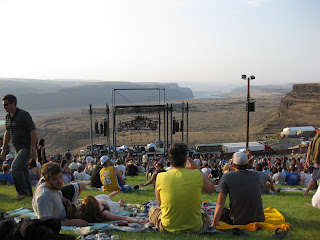 |
A special edition guitar named "Spirit of America." The guitar is made from
materials that were removed from the Statue of Liberty during the 1986
restoration. Photo by bridge used under Creative Commons license.
|
With the news that Les Paul died last week at the age of 94, the world of music lost a great musician, futurist innovator and the creator of some of rock and roll’s greatest gear.
Born June 9, 1915, Paul learned several instruments in his youth and played in several country bands in his teens. In the 1930’s he set out with a vision to revolutionize the electric guitar.
He built the first electric guitar pickup in 1934 using spare radio parts. He built his first prototype solid body electric guitar 1941. It was different from the hollow body guitars existing at the time, which vibrated and resonated to produce a tone.
Nicknamed “the log,” Paul’s creation was more like a railroad tie with a guitar neck and strings than it was a guitar. The guitar produced a tone (or signal) from the strings vibrating above a magnetic pickup, and the guitar body did not resonate much at all.
The first Les Paul guitars and similar guitar designs from Leo Fender and Adolph Rickenbacker were produced in the early 1950’s.
Once the design was tweaked and perfected, the Les Paul would become a top choice for guitarists from many genres. Artists continue to use the legendary axe and span multiple decades, including Jimmy Page of Led Zeppelin, Slash of Guns ‘n Roses, Bob Marley, George Harrison, Duane Allman, Chuck Berry, Billie Joe Armstrong of Green Day, Jimi Hendrix, Lindsey Buckingham of Fleetwood Mac, Joe Perry of Aerosmith, Frank Zappa, Randy Rhoads, Johnny Winter and Neil Young, to name a few.
The Les Paul guitar became a staple of famous rock and blues guitarists worldwide, and also a permanent fixture leaning in the corner of the living rooms of amateurs and enthusiasts everywhere.
In the 1940s, Paul built his first recording studio and began to pioneer some techniques that are still used today including microphone techniques, echo delay and multi-tracking. In the early ‘50s he built the first eight-track recorder, which allowed musicians to record sounds from several sources (simultaneously or one at a time) and mix them into a song, altering tone, volume and pan of each separate track. Multi-track recording is still widely used today and without it there would be no Sgt. Pepper’s, Pet Sounds or Dark Side of the Moon. Without Paul’s invention, the direction of the recording industry would be unknown.
His guitar playing was as unique as his guitar designs and Paul continued to play music up to the end of his career, putting out an album in 2008 and winning a Grammy in 2006 for “Les Paul and Friends: American Made World Played.” Throughout his career, Paul explored a few different genres, most notably country and jazz.
Upon learning of his death, many artists and musicians have spoken out to the news media about Les Paul’s influence and impact to the music world. Several bands have paid musical tribute by playing Paul’s tunes at their concerts.
The Les Paul guitar has come a long way from the prototype design, with hundreds of different models available. Gibson created several guitars in 2007 and 2008 such as the Robot Guitar and the Dark Fire that integrated computer systems into the Les Paul design. The advanced versions of the log allow for automatic computerized tuning of the tuning pegs and switching pickups and coils automatically while playing.
Recording systems have grown in complexity, but they are still just advanced versions of what Paul came up with in the 1950s.
So while Paul is now strumming with the likes of Jimi Hendrix and Bob Marley, his ideas continue to be the backbone of a musical tradition that will never die.
Originally published in the Lovell Chronicle.






